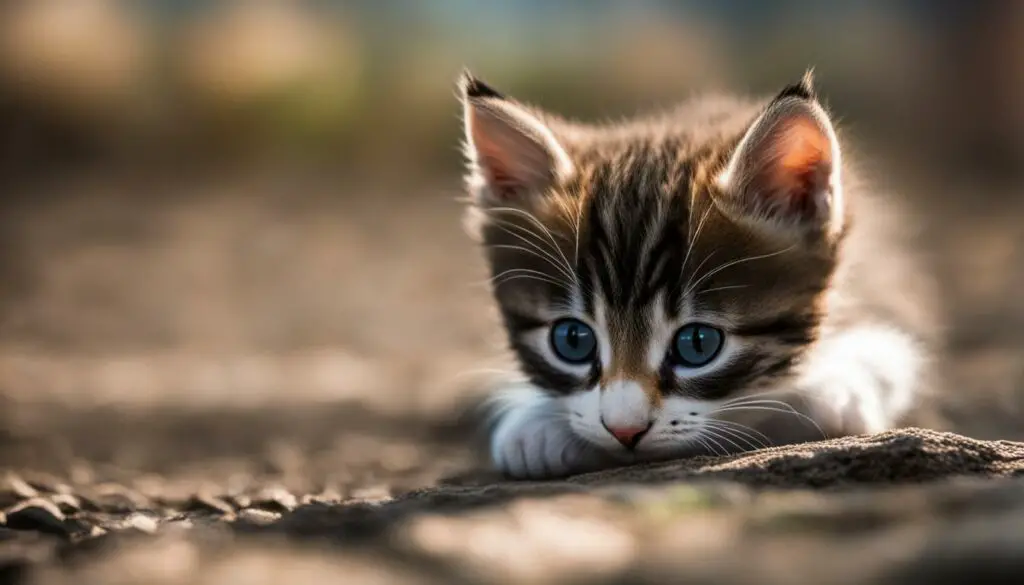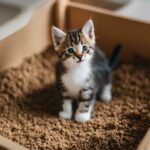Being separated from its mother at just 5 weeks old can pose challenges for a newborn kitten. Without its mother, the kitten may struggle with nutrition, behavior, socialization, and overall development. To ensure the healthy growth and development of a kitten separated at such an early age, proper care and attention are essential.
Key Takeaways:
- Separating kittens from their mothers at 5 weeks can have negative impacts on their development.
- Orphaned kittens may experience stunted growth, illness, and behavioral issues without their mother’s care.
- Proper nutrition is vital for orphaned kittens, and bottle-feeding with a formula designed for kittens is necessary.
- Early socialization is crucial for separated kittens to develop proper behavior and interaction skills.
- Grooming challenges and litter box training may require extra attention for kittens separated early from their mothers.
Importance of Nutrition for Orphaned Kittens
When a 5-week-old kitten is separated from its mother, it loses the essential nutrition provided by its mother’s milk. This can lead to various challenges in the kitten’s development and overall health. Orphaned kittens or those weaned too soon need to be carefully nourished to ensure their proper growth and well-being.
Feeding orphaned kittens requires specialized formulas designed for their nutritional needs. These formulas can be administered through bottle-feeding or shallow bowls, depending on the kitten’s preference and ability. It is crucial to closely monitor the kitten’s weight gain and adjust feeding schedules accordingly.
Proper nutrition is essential for the healthy development of orphaned kittens. It supports their physical growth, strengthens their immune system, and helps prevent health issues. By providing the necessary nutrition, caregivers can ensure that these kittens thrive despite being separated from their mothers at an early age.
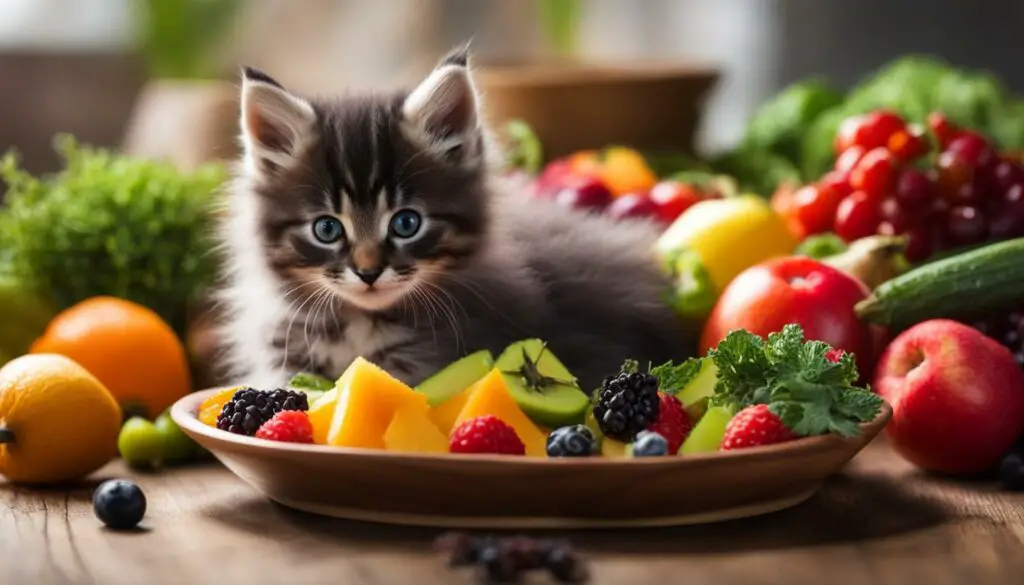
Growth Milestones for Orphaned Kittens
| Age (weeks) | Nutritional Needs | Feeding Frequency |
|---|---|---|
| 1-3 | Formula (5-7ml per feeding) | Every 2-3 hours, including overnight |
| 4-5 | Formula (9-12ml per feeding) | Every 3-4 hours, including overnight |
| 6-7 | Formula (12-15ml per feeding) | Every 4-5 hours, including overnight |
“Proper nutrition is the foundation for the healthy growth and development of orphaned kittens. By understanding their specific needs and providing them with the necessary nourishment, we can give these kittens the best chance at a happy and thriving life.” – Dr. Sarah Thompson, Veterinarian
Ensuring proper nutrition for orphaned kittens is a vital aspect of their care. By following feeding guidelines, monitoring their growth milestones, and consulting with a veterinarian for guidance, caregivers can help these kittens reach their full potential and lead healthy lives.
Effects of Early Separation on Behavior
When a young kitten is separated from its mother prematurely, it can have a profound impact on its behavior and social development. Kittens learn crucial socialization skills, such as play and interaction, from their mothers and littermates. Without this early exposure, these kittens may struggle to navigate social situations and exhibit fear or aggression towards other cats and humans.
Separation from their mother at a young age can cause kittens to feel a deep sense of loss and longing for their mother’s presence. This can lead to anxiety and difficulty coping with the separation. Without the guidance and support of their mother, these kittens may have trouble understanding social cues and boundaries.
“The absence of a mother figure can significantly impact a young kitten’s emotional well-being and behavior,” says Dr. Emily Johnson, a feline behavior specialist. “It’s important to provide these kittens with extra care and attention to help them overcome the challenges of early separation.”
Coping with Separation
In order to help young kittens cope with the effects of early separation, it is important to provide them with a nurturing and supportive environment. This includes creating a safe and comfortable space for the kitten to explore and play, as well as providing plenty of interactive toys and opportunities for social interaction.
Introducing the kitten to other kittens or friendly adult cats can also help them learn appropriate social behaviors. Positive reinforcement, such as treats and praise, can be used to encourage desirable behaviors and build the kitten’s confidence.
| Behavioral Challenges | Ways to Address Them |
|---|---|
| Fear or aggression towards other cats and humans | Gradual exposure to new experiences and individuals, along with positive reinforcement |
| Difficulty understanding social cues and boundaries | Providing clear and consistent guidance through gentle correction and redirection |
| Anxiety and longing for the mother’s presence | Creating a nurturing and comforting environment with plenty of love and attention |
By taking these proactive measures, caregivers can help young kittens navigate the challenges of early separation and promote healthy behavioral development.
Timely Socialization for Separated Kittens
When kittens are separated from their mothers too early, they may become timid and shy, struggling with socialization. Timely and positive interaction with humans and other animals is crucial for their development. By providing the right experiences and exposure at an early age, caregivers can help these kittens overcome their fears and become confident individuals.
One effective way to socialize separated kittens is through gradual introductions to new people, animals, and environments. Start by introducing them to calm and gentle individuals in a quiet setting. Allow the kittens to approach and interact at their own pace, providing encouragement and rewards for positive interactions.
Play sessions with interactive toys, such as feather wands or balls, can also help build confidence and encourage social engagement. These activities not only provide mental and physical stimulation but also help the kittens learn to trust and bond with their caregivers.
Positive Reinforcement
Positive reinforcement is a powerful tool in the socialization process. Whenever the separated kittens display desired behaviors, such as approaching a new person or playing with a fellow kitten, praise them with gentle words and rewards like treats.
Remember, patience is key in socializing timid kittens. Each kitten will have their own unique pace of progress, so it’s essential to respect their individual needs and comfort levels. With consistent and positive socialization efforts, these kittens can grow up to be well-adjusted and sociable cats.
Table: Socialization Tips for Timid Kittens
| Tips | Description |
|---|---|
| Gradual Introductions | Introduce kittens to new people, animals, and environments slowly and in a controlled manner. |
| Interactive Play | Engage kittens in play sessions with toys that encourage interaction and build trust. |
| Positive Reinforcement | Reward desired behaviors with praise and treats to motivate and reinforce positive socialization. |
| Patience | Respect each kitten’s individual pace and provide a safe and supportive environment for their growth. |
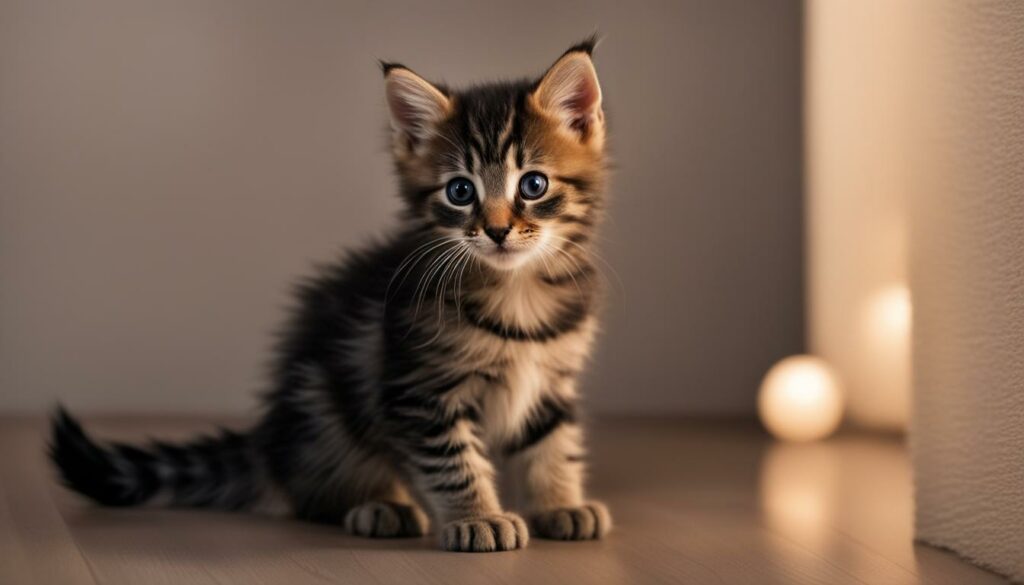
Grooming Challenges After Separation
Proper grooming is an essential aspect of a kitten’s overall well-being. When separated from their mothers at an early age, kittens may face challenges in learning how to groom themselves effectively. Without the guidance of their mother, they may struggle to develop proper grooming behaviors.
Grooming is not just about keeping their fur clean and free of tangles; it also promotes bonding and provides a sense of security for the kittens. Additionally, grooming helps stimulate blood circulation and keeps their skin healthy.
Caregivers play a crucial role in helping separated kittens with their grooming needs. One way to assist them is by providing regular brushing sessions. This not only helps keep their fur clean and mat-free but also mimics the gentle grooming touch of a mother cat. It is important to use a soft brush suitable for kittens to avoid any discomfort or injury.
Table: Grooming Tips for Separated Kittens
| Grooming Aspect | Tips |
|---|---|
| Brushing | Regularly brush their fur using a soft brush to keep it clean and tangle-free. |
| Eye and Ear Cleaning | Gently clean their eyes and ears with a damp cloth to remove any discharge or debris. |
| Nail Trimming | Trim their nails regularly to prevent overgrowth and discomfort. Use cat-specific nail clippers and be careful not to cut their quick. |
| Dental Care | Introduce daily dental care by gently brushing their teeth with a kitten-specific toothbrush and toothpaste. |
| Bathing | Although cats are known for their self-grooming abilities, if necessary, introduce them to occasional baths using cat-friendly shampoo and warm water. |
Remember, grooming sessions should be calm and positive experiences for the kittens. Always monitor their comfort level and adjust your approach accordingly. If you encounter any difficulties or notice any abnormalities during grooming, consult a veterinarian for further guidance.
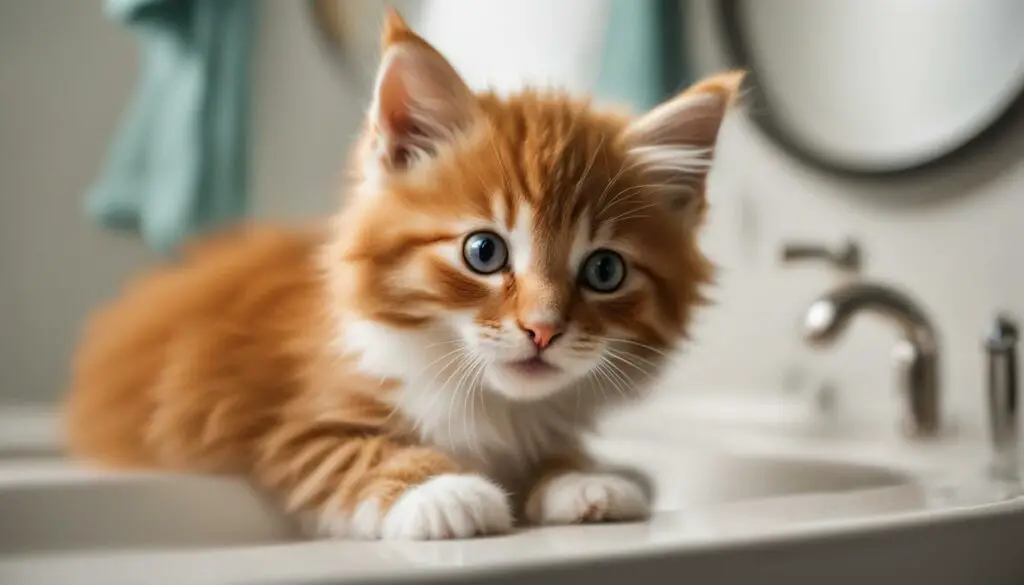
Section 6: Litter Box Training for Early Separated Kittens
When kittens are separated from their mothers before 8 weeks old, they may struggle with learning how to use the litter box effectively. Litter box training is an essential skill that kittens typically learn from observing their mothers and siblings. Without this guidance, caregivers must take an active role in teaching their separated kittens proper litter box habits.
One important step in litter box training is to provide a suitable litter box. Choose a box that is low-sided and easily accessible for the kitten. It should be filled with a non-clumping litter to prevent any potential health risks. Place the litter box in a quiet and easily accessible location where the kitten feels comfortable. Introducing the kitten to the litter box as soon as possible is crucial for their successful training.
To help the separated kitten understand the purpose of the litter box, gently place them inside the box after meals or when they show signs of needing to eliminate. Use your finger to gently scratch the litter, encouraging the kitten to dig and explore. Be patient and consistent with the training process, as it may take some time for the kitten to fully grasp the concept. Positive reinforcement, such as verbal praise or a small treat, can be used to reward the kitten for using the litter box correctly.

Common Challenges and Troubleshooting:
- Resistance to the litter box: Some separated kittens may initially show resistance to using the litter box. In such cases, ensure that the litter box is kept clean and free of any unpleasant odors. Consider using a litter attractant or placing a small amount of the kitten’s waste in the litter box to encourage them to use it.
- Accidents outside the litter box: If the kitten consistently has accidents outside the litter box, it may be necessary to confine them to a smaller area with easy access to the litter box. Gradually increase their access to the rest of the living space as their litter box habits improve.
- Multiple litter boxes: In multi-cat households, it is recommended to provide multiple litter boxes to prevent competition and ensure each cat has easy access to a clean box. This is especially important for separated kittens who may require additional training support.
Litter box training is a crucial aspect of the overall care and well-being of separated kittens. Patience, consistency, and gentle guidance are key to helping these kittens develop proper litter box habits and become confident, well-adjusted cats.
Providing Optimal Care for Separated Kittens
When you adopt a separated kitten, it is important to provide them with the optimal care they need to thrive. By creating a warm and safe environment, supplying appropriate nutrition, and offering plenty of social interaction and playtime, you can ensure that your separated kitten grows up healthy and happy.
One of the key aspects of caring for a separated kitten is to provide a warm and safe environment. Orphaned kittens are unable to regulate their body temperature effectively on their own, so it’s crucial to provide them with a heat source, such as a heating pad or a warm blanket. This will help keep them warm and comfortable, ensuring their wellbeing.
In terms of nutrition, it’s important to feed your separated kitten a formula designed for kittens. Follow the feeding guidelines provided by the formula packaging and establish a feeding schedule based on the kitten’s weight gain. Consulting with a veterinarian can help ensure you’re meeting the specific nutritional needs of your separated kitten.
| Feeding Guidelines for Separated Kittens | Recommendations |
|---|---|
| Formula | Feed a formula designed for kittens, following the instructions on the packaging. |
| Body Warmth | Maintain proper body warmth during feeding to keep the kitten comfortable. |
| Feeding Schedule | Establish a feeding schedule based on the kitten’s weight gain and consult with a veterinarian for guidance. |
| Nursing Technique | Ensure the kitten is nursing properly by gently holding their mouth open and allowing them to suckle at their own pace. |
Lastly, social interaction and playtime are essential for the development and happiness of your separated kitten. Spend quality time with them, engaging in interactive play sessions and providing opportunities for exploration. This will help them develop proper social skills and ensure they grow up to be confident and well-adjusted individuals.
Remember, caring for a separated kitten can be a rewarding experience, but it requires dedication and attention to their specific needs. By providing optimal care in terms of their environment, nutrition, and socialization, you can ensure that your separated kitten thrives and enjoys a happy, healthy life.
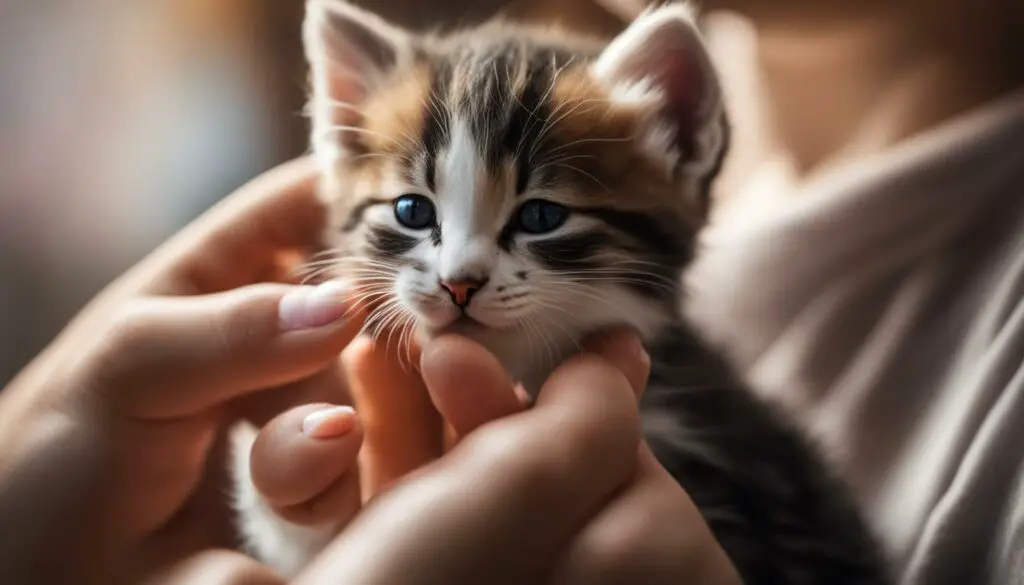
Transitioning to Solid Food during Weaning
As kittens reach around 5 weeks old, they begin the gradual process of transitioning from their mother’s milk to solid food. This phase, known as weaning, is a crucial step in their development and prepares them for independent eating. While kittens that have been separated from their mothers early may face some challenges during this transition, proper care and attention can help them succeed.
When introducing solid food to separated kittens, it is important to start with a soft and easily digestible option. Wet food or a mixture of wet food and formula can be offered to encourage the kittens to explore and taste solid textures. In the beginning, the food may need to be mashed or softened with warm water to make it easier for the kittens to eat.
It is recommended to offer small portions of food multiple times a day to prevent overwhelming the kittens. Gradually, the ratio of milk to solid food can be adjusted, reducing the amount of milk offered and increasing the amount of solid food. This gradual shift allows the kittens to gradually adjust to the new diet without causing digestive upset.
During the weaning process, it is crucial to closely monitor the kittens’ progress. Ensure that they are eating enough and gaining weight. If any concerns arise, consult a veterinarian for guidance and support. With patience and consistency, separated kittens can successfully transition to a diet of solid food and continue to thrive on their journey to adulthood.

Table: Sample Weaning Schedule
| Week | Age (in weeks) | Feeding Instructions |
|---|---|---|
| 1 | 5-6 | Introduce wet food mixed with formula, offer twice a day. |
| 2 | 6-7 | Gradually reduce formula, increase the amount of wet food, offer three times a day. |
| 3 | 7-8 | Transition to solely wet food, offer four times a day. |
| 4 | 8-9 | Introduce dry kitten food, offer small amounts alongside wet food, four times a day. |
| 5 | 9+ | Gradually reduce the frequency of meals to three times a day, increase the amount of dry food. |
Ensuring Warmth and Hydration for Separated Kittens
When caring for orphaned kittens or those separated from their mothers at 5 weeks old, it is important to prioritize their warmth and hydration needs. These young kittens are unable to regulate their own body temperature, so providing a warm environment is essential for their overall well-being.
To ensure a warm environment, you can use a heating pad set to a low temperature or place a warm blanket in their sleeping area. It’s important to regularly check the temperature to make sure it is neither too hot nor too cold for the kittens.
In addition to warmth, proper hydration is crucial for the health of separated kittens. Fresh water should always be available to them, and caregivers should monitor their water intake to ensure they are adequately hydrated. If necessary, you can also consult with a veterinarian for additional guidance on the specific hydration needs of your separated kittens.
Benefits of a Warm Environment:
- Helps maintain body temperature and prevents hypothermia
- Supports healthy growth and development
- Promotes comfort and relaxation
Importance of Hydration for Kittens:
- Prevents dehydration and associated health issues
- Aids in digestion and nutrient absorption
- Supports proper kidney function
“Providing a warm environment and ensuring adequate hydration are essential for the well-being of separated kittens. By meeting these basic needs, caregivers can help the kittens thrive and grow into healthy cats.”
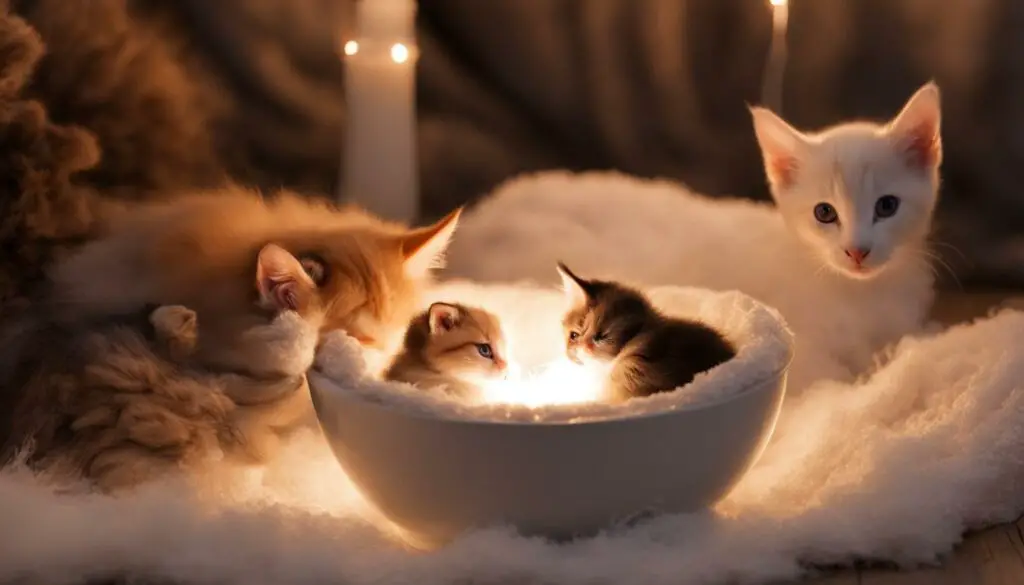
| Signs of Hypothermia in Kittens | Prevention and Solution |
|---|---|
| Shivering | Ensure a warm and draft-free environment. |
| Weakness and lethargy | Provide a heating pad or warm blanket. |
| Cool to the touch | Regularly check the temperature in their sleeping area. |
| Reduced appetite | Monitor their food and water intake. |
Feeding Guidelines for Separated Kittens
When caring for separated kittens, proper feeding is essential for their growth and development. Orphaned kittens should be fed a formula designed for kittens through a bottle or shallow bowl. Here are some feeding guidelines to ensure their well-being:
- Maintain proper body warmth: Provide a warm environment for the kittens during feeding to keep them comfortable. Use a heating pad or a warm blanket to maintain their body temperature.
- Prepare formula according to packaging instructions: Follow the instructions on the formula packaging to prepare the right concentration of formula for the kittens. Use clean bottles or shallow bowls for feeding.
- Establish feeding schedules based on weight gain: Monitor the kittens’ weight gain and consult with a veterinarian to determine the appropriate amount and frequency of feedings. Adjust the feeding schedule as the kittens grow.
- Ensure proper nursing: Properly position the bottle or shallow bowl to allow the kittens to nurse comfortably. Observe their suckling behavior and ensure they are latching properly.
Consult with a veterinarian to address any specific concerns or questions regarding the feeding of separated kittens. They can provide further guidance and support to ensure the kittens receive the nutrition they need for healthy development.

Bottle-Feeding Tips
Bottle-feeding orphaned kittens requires special attention and care. Here are some additional tips to help with the feeding process:
- Hold the bottle at an angle: Hold the bottle at a 45-degree angle to prevent the kittens from swallowing too much air while feeding.
- Burp the kittens: Gently pat their backs to help them release any trapped air and prevent discomfort.
- Monitor their milk intake: Keep track of the amount of milk the kittens consume during each feeding to ensure they are getting enough nutrition.
Remember to provide a nurturing and supportive environment during feeding time. Show love and care to the separated kittens, as they rely on you for their well-being and development.
Handling Separated Kittens during Feeding
Feeding orphaned kittens or those separated from their mothers at 5 weeks requires special attention and gentle handling techniques. Proper burping and handling during feeding can help prevent discomfort and digestive issues, ensuring the kittens receive the nutrition they need to thrive.
Burping Orphaned Kittens
Similar to human babies, kittens can swallow air while bottle-feeding, leading to discomfort and potential digestive problems. To prevent this, it is important to burp them after each feeding session. Gently hold the kitten against your chest or over your shoulder and pat their back in a rhythmic motion. This can help release any trapped air and promote healthy digestion.
Gentle Handling during Feeding
When feeding separated kittens, it is crucial to use gentle handling techniques to ensure their safety and comfort. Hold the kitten securely but avoid applying excessive pressure or restraining their movements. Support their head and neck with one hand and use the other hand to guide the bottle or syringe into their mouth.
Allow the kitten to suckle at their own pace, as forcing them to eat too quickly can lead to choking or aspiration. If the kitten resists or shows signs of distress during feeding, take a break and try again later. It is important to create a calm and nurturing environment during feeding sessions.
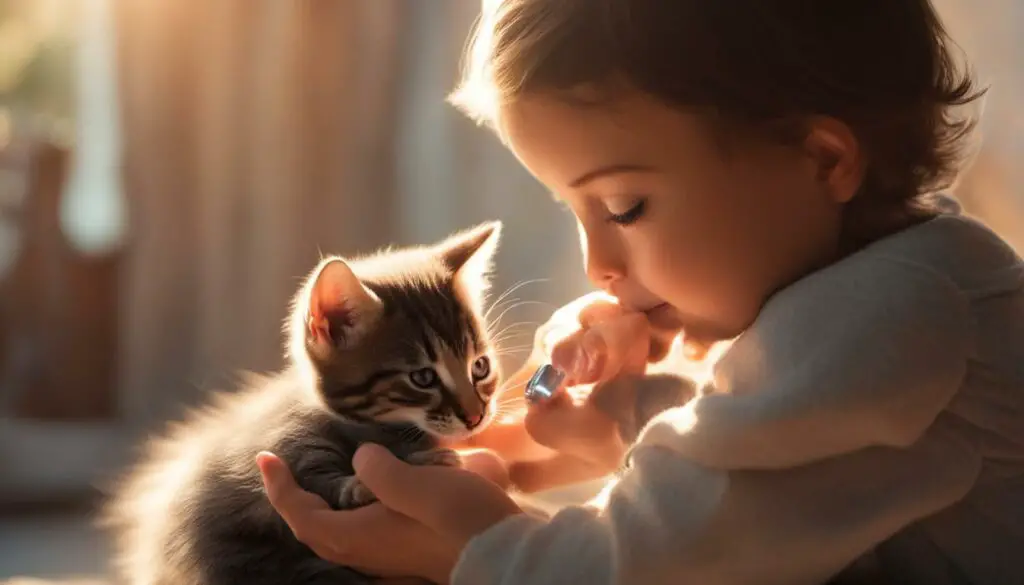
Remember, each kitten is unique, and their comfort and well-being should always be the top priority. By practicing gentle handling techniques and ensuring a comfortable feeding experience, you can help separated kittens grow and thrive.
Gradual Transition to Solid Food during Weaning
During the weaning process, it is important to gradually introduce solid food to orphaned kittens or those separated from their mothers at 5 weeks old. This transition period is crucial for their nutritional development and independence. By following a step-by-step approach, caregivers can ensure a smooth and successful transition from milk to solid food.
First, start by offering a small amount of wet food or a mixture of wet food and formula on a shallow plate or saucer. Gently dip your finger into the food and allow the kitten to lick it off. This helps them get familiar with the taste and texture of solid food. Gradually increase the amount of wet food offered over time. It is important to monitor the kitten’s response and ensure they are comfortable with the new food.
As the kitten becomes more comfortable with wet food, gradually reduce the amount of formula mixed in. This encourages them to eat the solid food directly and become less reliant on the bottle. You can also start introducing a small amount of dry kitten food, which should be soaked in warm water or formula to make it easier to chew and digest. Slowly increase the proportion of dry food as the kitten becomes more confident in eating solids.
Example:
“The weaning process is a gradual journey for separated kittens. At first, they may be hesitant to try solid food, but with patience and encouragement, they will eventually make the transition. It’s important to offer a variety of textures and flavors to keep them interested and ensure they are getting a well-rounded diet.”
Remember to provide fresh water alongside the solid food to keep the kitten hydrated. Monitor their progress closely and make adjustments as needed. Each kitten may have a slightly different pace of transition, so it is essential to be observant and responsive to their individual needs. Consulting with a veterinarian can provide valuable guidance and ensure that the kitten is receiving the necessary nutrients during this important developmental phase.
| Key Points | Benefits |
|---|---|
| Gradually introduce solid food | Allows for a smooth transition and prevents digestive issues |
| Start with wet food | Helps kittens get accustomed to the texture and taste of solid food |
| Reduce the amount of formula over time | Encourages independent eating and reduces reliance on the bottle |
| Introduce soaked dry food | Provides variety and helps develop chewing skills |
| Monitor progress and adjust accordingly | Ensures the kitten’s individual needs are met |
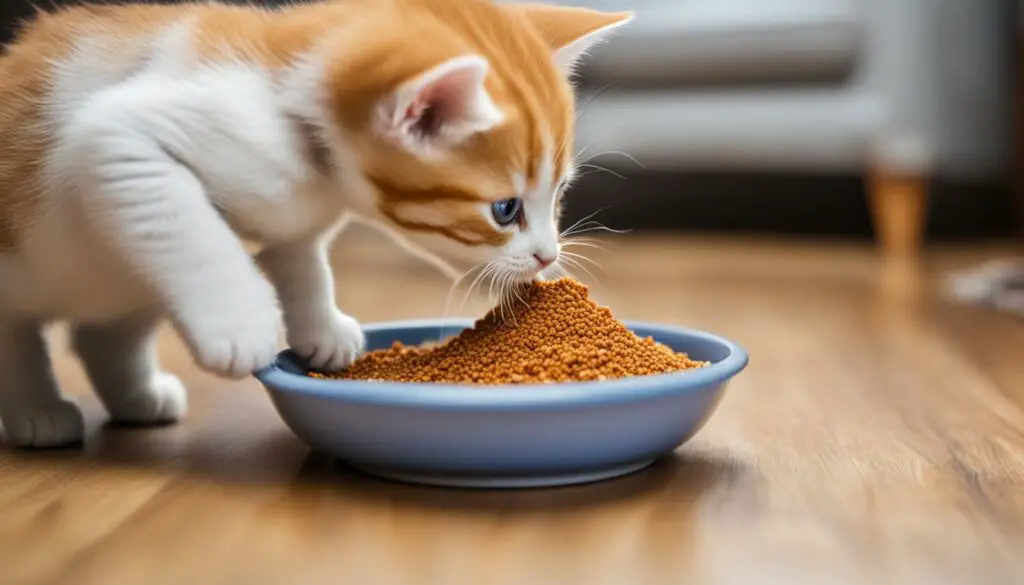
Summary:
During the weaning process for separated kittens, a gradual transition to solid food is essential. Start by offering small amounts of wet food, gradually reducing the amount of formula mixed in. Introduce soaked dry food to develop chewing skills. Monitor the kitten’s progress closely, and provide fresh water alongside the solid food. Each kitten may have a different pace, so it is important to be observant and responsive to their individual needs. Consulting with a veterinarian can ensure the kitten is receiving the necessary nutrients and support during this crucial developmental phase.
Conclusion
In caring for a kitten separated from its mother at 5 weeks, it is essential to understand the specific needs of these young felines. With proper attention and care, these separated kittens can thrive and develop into healthy and happy cats.
Providing optimal nutrition, warmth, and hydration are fundamental for their well-being. Feeding guidelines, including bottle-feeding with a formula designed for kittens, should be followed to ensure proper growth and development. Gradually transitioning to solid food during weaning and monitoring their progress is crucial in facilitating independent eating habits.
Additionally, socialization and grooming play significant roles in the overall development of separated kittens. Creating opportunities for positive interactions with humans and other animals is essential for their social skills and confidence. Gentle grooming guidance and regular brushing sessions help them learn proper hygiene behaviors.
In conclusion, by understanding and meeting the specific needs of separated kittens, such as nutrition, socialization, grooming, and proper care, we can ensure their healthy growth and development. With the right support and attention, these kittens can thrive and live fulfilling lives as beloved companions.
FAQ
What challenges can a newborn kitten face if separated from its mother at 5 weeks old?
When separated from their mother too early, kittens can experience difficulties in terms of nutrition, behavior, socialization, and overall development.
How long should kittens stay with their mothers?
It is recommended that kittens stay with their mothers until at least 8 weeks old to receive essential nutrients and important life lessons.
What can happen if a kitten is weaned too soon?
Kittens weaned too soon may experience stunted growth, illness, and behavioral issues.
How can I provide proper nutrition for an orphaned kitten or one separated from its mother early?
Orphaned kittens or those weaned too soon need to be bottle-fed with a formula designed for kittens to ensure they receive proper nutrition.
What impact does early separation have on a kitten’s behavior?
Kittens separated from their families too early may exhibit fear or aggression and struggle with socialization and proper interaction with other cats and humans.
How can I help a separated kitten develop better social skills?
Exposing orphaned kittens to other kittens and a variety of people and animals can help them develop better social skills and become more confident individuals.
What can I do to help a separated kitten overcome shyness and fear?
Early and positive interaction with humans, starting as early as 10 to 12 weeks old, is crucial for their social development.
How can I ensure proper grooming for a kitten separated from its mother?
Caregivers should provide gentle guidance and ensure that these kittens receive regular brushing and grooming sessions to learn and practice proper grooming behaviors.
How can I help a separated kitten learn proper litter box habits?
Caregivers should provide guidance and assistance in litter box training, such as gently placing the kitten in the litter box and demonstrating digging motions.
What should I do if I have adopted a separated kitten?
It is important to provide a warm and safe environment, appropriate nutrition, and plenty of social interaction and playtime for the well-being of a separated kitten. Seeking guidance from a veterinarian is also essential.
When should I start weaning a separated kitten?
Weaning usually starts around 4 weeks old. For separated kittens, caregivers can begin introducing wet food or a formula mixed with food to encourage independent eating.
How can I ensure warmth and hydration for an orphaned kitten?
Caregivers should provide a heat source, such as a heating pad or warm blanket, to keep the kittens warm. Proper nutrition and access to fresh water should also be provided.
What are the feeding guidelines for a separated kitten?
Feeding guidelines include maintaining proper body warmth, preparing formula according to packaging instructions, establishing feeding schedules based on weight gain, and ensuring the kitten is nursing properly.
How should I handle a separated kitten during feeding?
Proper positioning, such as holding the kitten on their stomach, is crucial during feeding to avoid aspiration. Gentle handling techniques, like opening the kitten’s mouth with a finger, should be used.
How do I transition a separated kitten to solid food during weaning?
Gradually introduce solid food by dipping a finger into the food and allowing the kitten to lick it off. Mixing formula with wet food and gradually increasing the ratio of food can also help with the transition.

